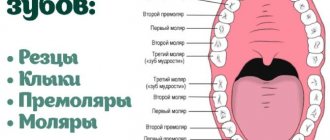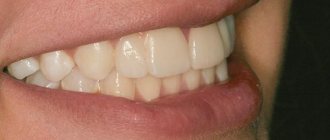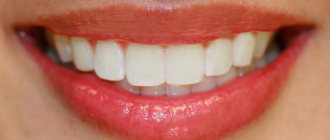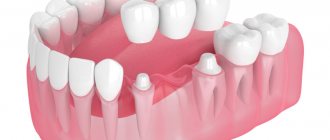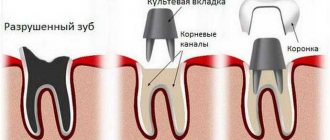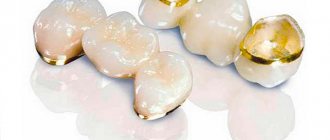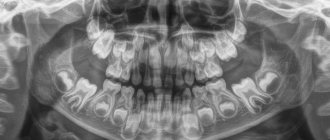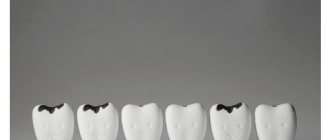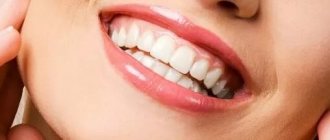“Mom, I want a big chocolate!” - the three-year-old child bursts into loud hysterics throughout the store. The blushing mother, embarrassed in front of the public, hastily buys what she needs. The situation repeats itself constantly and is aggravated, moreover, by the love of adults who strive to treat the baby with something tasty. And after a while, the baby begins to complain of toothache... But sweets are only one of the reasons why caries occurs in children’s baby teeth; Olga Dzedzits, a leading specialist in pediatric dentistry at Inpromed in Moscow, told us about other possible reasons.
How to identify milk caries?
It is quite simple to identify caries in young and older children. White or brown spots appear on the teeth, a painful reaction to hot and cold is observed, and the child may develop bad breath. When these first symptoms of caries appear, it is already worth sounding the alarm, since the carious process is developing very rapidly. It is characterized by almost instantaneous damage to several teeth, and if measures are not taken, the entire dentition may be affected. Of course, it is often difficult for a child to articulate that his baby tooth hurts. He may refuse to eat or chew on only one side. This should also alert parents and encourage them to take their child to pediatric dentistry.
What are the causes of caries in primary teeth?
There are more reasons for caries of baby teeth in children than meets the eye. This includes improper oral hygiene, sharing cutlery with adults who have caries, and much more. However, the main causes of occurrence are the influence of consumed carbohydrates that destroy the tooth, accidental infection from a carrier of a carious infection, a genetic factor, the immaturity of the children's skeletal system, and improper use of pacifiers and nipples.
- Of course, the main and most common cause of caries in primary teeth in children is poor oral hygiene and the influence of sweets. According to statistics, caries develops in young children in 73% of cases. Sucrose, glucose and fructose are the acids that are formed during the fermentation of carbohydrates and lead to the destruction of enamel. Immediately after ingestion of carbohydrates, the pH of saliva decreases from 6 to 4, and pathogenic bacteria settle in food debris that is not cleaned from the teeth.
- Remember the children's saying “from mouth to mouth you get a germ”? It turns out that she is not so far from the truth. The fact is that caries is an infection, an infection. That is, a loving parent, being a potential carrier of carious microbes, does not even suspect that by kissing his baby or sharing dinner with him, he can personally infect his child!
- Another reason why caries may occur on baby teeth is genetic. Teeth begin to form during the prenatal period, in the first trimester of pregnancy. Therefore, smoking by a negligent parent, her illnesses suffered during this period, or taking medications can lead to disruption of the proper development of the child’s teeth.
- Childhood caries of primary teeth may be associated with the following factor: children’s teeth have a low degree of mineralization and erupt “immature”, and only then “mature” in the oral cavity. Final mineralization lasts for one and a half to two years for baby teeth and about three years for permanent ones. Pediatric dentists call such periods of “maturation” the most susceptible to caries. Therefore, the reasons why caries occurs in primary teeth at an early age may also be chronic diseases, the effects of medications, the composition of saliva and the fluoride content in water and food.
- Another cause of caries of primary teeth in young children is improper use of pacifiers. A baby who falls asleep with a bottle in his mouth runs the risk of getting caries on his front teeth, so-called bottle caries. In this case, prolonged contact of the sweet liquid with the teeth leads to caries of all front teeth. In this case, the disease spreads around the entire visible part of the tooth along the perimeter.
As you can see, there are more than enough reasons for the appearance of childhood caries in baby teeth. But they all boil down, as a rule, to demineralization of teeth and destruction of hard tissues. Characteristic changes occurring in teeth can only be diagnosed by a dentist. Further treatment will depend on how severe the caries has developed. What are the stages of development of caries in primary teeth?
Types of fungi
Candida are representatives of normal microflora. Several types of candida are known, which can also be pathogens. Fungal gastroenteritis is observed in severely weakened children and the elderly, as well as people of any age with significant immune deficiency of various origins. They are characterized by a gradual onset, bloating, infrequent loose foamy stools, rumbling and various soreness, nausea, vomiting, and cramping abdominal pain. In very severe cases candidasepsis may occur. Secondary infection easily develops on the affected surfaces. The disease is getting worse. Such a course of candidiasis is possible only in a dirty intestine, with blockages from a mixed meat and dairy diet in the body with a high deficiency of silicon, which is capable of excreting candida with feces. In practice, 90% of those consulted suffer from candidiasis.
Cryptococci - cause subacute or chronic deep mycosis. Most often (70%) this disease occurs in people with a mixed diet who have overloaded the enzymatic apparatus of the stomach. In such cases, even baker's yeast can cause cryptoccosis due to the infinitely large expenditure of acid to neutralize alkaline enzymes coming from the mouth with carbohydrate foods that were eaten along with protein. To get rid of this disease, it is necessary to remove the root cause of the disease - overload of the acid-forming gastric mucosal bioapparatus, use only separate nutrition, cleanse the intestines, and only then will antimycotic treatment be successful.
Penicildia - cause deep mycoses, caused by a variety of green molds that can affect the skin, mucous membranes, external auditory canal, and internal organs. Penicilliums occur after the use of antibiotics. Nocardia asteroides are aerobic, immobile formations that occupy an intermediate state between fungi and bacteria. Most are saprophytes, but can cause diseases in humans and animals. Nocardiosis can be expressed as mycetoma -. a tumor in the lungs consisting of a dense plexus of mold.
A close relative of Nocardia asteroides is Actinomycetes isrielii. They cause severe mycotic lesions of the cervicofacial region, chest and abdominal cavities - granulomas. This fungus is most often found in people living in areas of high radiation, as well as working in hazardous chemical production.
Mucor fungi cause a disease very similar to tuberculosis - mucophomycosis.
Aspergillus is a fungus that includes many species. Some of them are pathogenic. They are capable of deeply affecting tissues. They release toxins and give rise to malignant formations.
Geotrichosis is a disease caused by fungi that attack the mucous membranes. They accompany diseases - otitis media, sinusitis.
Trichophyton is a fungus that causes diseases of the skin, hair, and nails. It is rare to find a person who is not contaminated with trichophyton.
Trichophytis - causes ringworm disease. Trichophytosis can be superficial or chronic. Superficial trichophytosis is characterized by the appearance of erymatous peeling on the scalp. The fungus penetrates the hair, destroys it, the hair breaks, which is why the name “ringworm” is associated.
Epidermophyton floccosum is the causative agent of lichen nigricans. This disease manifests itself as slightly scaly dark brown or black spots, most pronounced on the extremities. Penetration of the fungus into the skin can be deep, and upon recovery, when the black spots disappear, the skin regains its ability to pigment (change color from exposure to the sun) for 2-3 years. At this time, non-tanning spots from ringworm black appear on the arms and legs. The disease recedes with the usual antimycotic treatment with celandine juice.
Microsporiums are fungi that cause the disease microsporia, which affects the skin, hair and nails. Exposure to all kinds of creams, ointments, powders and rubs either does not give a healing effect, or gives a very short-term improvement in health. To completely get rid of microsporia, it is necessary to take antimycotic treatment from inside the body.
Mycosis fungoides - causes the disease mycosis fungoides - a malignant tumor lesion of the lymph vessels, the fungus initially settles on the skin, and then colonizes the lymphatic system.
Mycoplasmas Fluor - cause inflammatory processes mainly in the respiratory organs and in the genitourinary system.
Sporothrix is a fungus that attacks muscles, bones, and internal organs.
All fungi produce poisons that cause a wide variety of allergic reactions. Toxins from aspergilus fungi have a toxic effect on the liver.
Yeast species: Candida, Candida albicans, Cryptococcus, Trichosporum, Saccharomyces.
Molds: trichophyton, microsporium, epidermiphyton, aspergillus, mycosis.
Stages of caries of primary teeth
Dentists distinguish the following stages of caries of primary teeth in children:
- Elementary;
- Surface;
- Average;
- Deep;
Initial caries of primary teeth
Initial caries of baby teeth can be recognized as follows: white spots of different shapes and sizes appear on the enamel, but there is no pain. In an “advanced” case, the initial caries progresses - the spots darken, becoming brown and then black.
Superficial caries of primary teeth
With superficial caries of primary teeth, the dental tissue defect is located within the enamel, and the carious cavity can be either light or dark. However, in this case, pain occurs when the tooth comes into contact with sweet, sour or salty foods. In this case, treatment of the baby tooth and filling of the cavity is already required.
Average caries of primary teeth
Average caries of primary teeth affects the enamel and internal dental tissue, dentin. In addition to the unpleasant sensations from sweet, sour and salty, pain from hot and cold is added. In this case, just as with superficial caries of primary teeth, filling is necessary.
Deep caries of baby teeth
With deep caries of primary teeth, the enamel and a significant part of the dentin are affected. If treatment is not carried out at this stage, then caries can affect the pulp of the tooth and then reach the root, often causing a cyst in baby teeth. Here you just need to see a doctor before the infection goes further. In this case, severe caries of primary teeth and its treatment will depend on how deep the caries has spread.
Pasteurization of milk
This is also an interesting experiment that can be done at home, only aimed at destroying bacteria.
The world owes the appearance of shelf-stable milk (pasteurized) to the Frenchman Louis Pasteur. This scientist developed a process to kill microorganisms found in liquids. True, Pasteur processed wine and beer, not milk.
In a regular kitchen you can easily pasteurize milk. To do this, place the container with milk in a steam bath (in a pan with hot water) and, with constant stirring, bring it to a temperature of 63 - 65⁰C. After half an hour, the container with milk is transferred to cold water to quickly reduce the temperature.
Is caries treated in baby teeth?
Is it necessary to treat caries on baby teeth? This question still remains open for some parents. Even knowing that the child has caries, they are in no hurry to see a doctor, thinking as follows: “the milk teeth will fall out anyway.” Such judgments are absurd, because infected baby teeth will lead to complications in the growth of permanent teeth or provoke an exacerbation of other diseases in the baby’s body. One way or another, you will have to remove the baby tooth ahead of time. Caries in pediatric dentistry is considered one of the most common diseases, so both parents and specialists should ask the question “why is it necessary to treat caries of primary teeth?” Dentists believe that treatment of caries in a baby tooth will preserve it until the “arrival” of the molars.
Treatment of caries of primary teeth in children
If the doctor finds that a child has incipient caries, then most likely, treatment of baby teeth will not be required. The specialist will protect the enamel from further destruction using a painless and effective procedure - applying fluoride varnish or a silver fluoride compound. Then, when the baby gets permanent teeth, the dentist can seal the fissures - the depressions between the elevations of the tooth - which will prevent the occurrence of bacterial plaque that destroys the enamel. If caries progresses, you can no longer do without filling. The doctor will quickly and almost painlessly remove the affected tissue and hermetically seal the tooth. Otherwise, caries can develop into pulpitis in a child, and then into periodontitis.
Stages of treatment of caries of primary teeth
- Before administering anesthesia, the doctor must numb the injection site using special gels or spray. Moreover, the content of the anesthetic component should be minimal. Anesthesia is, as a rule, carried out only in cases where pulp removal is required - that is, with medium and deep caries of primary teeth.
- It is advisable to remove affected tissue using hand tools or a drill, taking frequent breaks.
- As fillings, materials that can be applied “one time” should be used in order to reduce the operation time.
- If a child has deep caries of primary teeth and its treatment requires the necessary filling of the roots, then the canals are disinfected without special mechanical treatment and filled with a special paste.
- Treatment of baby teeth in children should take no more than half an hour, otherwise the child will get tired.
- Treatment of severe caries of primary teeth, as a rule, takes place in several stages and requires the use of sedation.
- Dental treatment under general anesthesia in children is carried out strictly according to indications;
You can get rid of carious lesions at the initial stage using modern methods of caries treatment without a drill. Comfortable, painless treatment is suitable for those children who are afraid of manipulation with a dental bur. The cost of treating caries in baby teeth without a drill is slightly higher than the price of traditional dental treatment for children, but it is worth it. If simple caries gives complications, then you will have to resort to classic drilling. The cost of treatment of complicated caries of primary teeth will depend on the degree of neglect of the disease.
Photos of teeth under a microscope or what plaque actually looks like
- Login Registration
- Home →
- News and articles on dentistry →
- Humor, relaxation →
- Photos of teeth under a microscope or what plaque actually looks like
While you might think these photos are of rare plants or exotic landscapes, what you're actually seeing is photos of plaque and microorganisms living in your gum area or on your toothbrush, as well as the decay caused by these bacteria. The images were obtained using a microscope that uses a directed flow of electrons for imaging. To make the details more clear, the images were processed using computer graphics.
Dental plaque under a microscope (400x magnification, photograph on 10-centimeter film). It is an accumulation of bacteria in the form of a film trying to colonize the surface of the tooth.
The same plaque at 10 thousand times magnification.
Photo of a baby tooth (incisor). Most of the tooth consists of dentin, a substance that envelops the cavity in which soft connective tissue, blood vessels and nerves are located. The crown of the tooth is covered with enamel (in the photo - the white area above the dentin). This is a stronger, mineralized substance that protects dentin from the effects of acids in the oral cavity. The root of a healthy tooth does not come into contact with acids in the mouth; in this part, dentin is protected by a cementitious substance (pink in the photo). It serves to adhere the periodontal ligaments to the surface of the tooth, reliably fixing its position.
The photo shows a section of a tooth. Blue indicates the enamel-forming layer of the cell, yellow indicates the surface of the tooth, and red indicates dentin. Depletion of the enamel or cementum exposes dentin (a porous substance with microscopic channels called dentinal tubules connecting the pulp), causing tooth sensitivity.
Yellow indicates the layer of bacteria that forms plaque on the surface of the tooth. During the digestive process, bacteria release acid, which causes demineralization of the tooth. As a result, caries develops, requiring treatment and installation of a filling, otherwise the carious lesion can lead to tooth extraction.
An incisor with a carious cavity or demineralization of the tooth caused by bacterial activity. In this case, caries formed on the lateral surface (between two teeth). Also visible in the photo is cervical caries (between the crown and the root of the tooth - indicated in yellow), which appeared due to improper or insufficient use of dental floss.
Yellow indicates the accumulation of bacteria on the gums.
Tooth surface (yellow) with a colony of spherical bacteria (blue) and red blood cells (red).
Toothbrush bristles.
The bristles of a used toothbrush are covered with plaque. After cleaning, rinse the brush thoroughly and remove any remaining toothpaste or plaque particles from it, then dry it in an upright position.
Plaque on the bristles of a used toothbrush at 750x magnification.
Special interdental brushes with a small head covered with bristles, designed to clean teeth in hard-to-reach areas.
Detailed image of a used interdental brush covered in plaque.
Crown of a baby tooth. The root of the tooth has become exfoliated as a result of temporary tooth resorption caused by the pressure of the growing molar.
A colony of bacteria forming plaque at 1000x magnification.
Plaque at 8 thousand times magnification.
A drill attachment designed to remove soft tissue and bacteria from a carious cavity.
Calcium phosphate crystals contained in dental solutions for remineralizing teeth.
Pin (used to strengthen the filling in case of extensive carious lesions or the absence of part of the tooth).
Prevention of caries in children
Prevention of childhood caries includes several areas, which boil down to proper nutrition, as well as home and professional hygiene.
- Individual oral hygiene. Home hygiene means that as soon as the first tooth hatches, a brush for the baby should appear in a glass next to the parents’ brushes. The same applies to toothpaste. At first, the paste can be applied to gauze or a fingertip to clean your teeth so as not to injure your delicate gums. You need to clean your teeth from all surfaces vertically, then wipe them with a brush soaked in water. Thus, firstly, plaque will be removed, and, secondly, parents will teach the baby to take care of the oral cavity.
- Prevention of caries with the help of a well-chosen diet. As for nutrition, parental duty is to breastfeed the baby from the very beginning. There is no need to talk about the beneficial properties of breast milk, and the sucking process greatly affects the developing jaw system. Then the baby should be accustomed to fermented milk products. By six months, the child should be fed kefir, and later - cottage cheese and cheese. Parents should remember that the main formation and formation of permanent teeth occurs up to 3 years. This means that calcium must always be present in the daily diet.
- Professional oral hygiene. This type of prevention involves periodic visits to the dentist and hygienist. The first visit should occur on your first birthday. The specialist will not only give recommendations for care, but also create a diet regimen and examine the mouth. When the first teeth emerge, you and your child will be shown how to brush their teeth properly at an appointment with a hygienist. If there is a problem such as tartar in children, you cannot do without professional hygienic cleaning. It is important for parents to make it a rule to visit the doctor twice a year. And if there are problems with teeth, then more often - once every three months. This is largely due to the fact that various pathologies develop too quickly in childhood. Meanwhile, early diagnosis will lead to quick, painless and relatively inexpensive treatment of caries.
As you can see, in most cases, when caries can attack children's teeth, parents are able to rebuff it decisively. Of course, there is no escape from genetic predisposition. But it’s not without reason that dental experts say that sweets are the main cause of the development of the disease! So isn’t it better to eliminate the constant source of bacteria and, instead of harmful carbohydrates, offer the child fruits, which are much healthier, after the main meal? Ultimately, your child will thank you in the future for being vigilant and maintaining healthy teeth!
Make an appointment
right now!
Dzedzits Olga Alekseevna
Surgeon, Therapist, Pediatric dentist, Hygienist
Setting up the microscope
First of all, you need to set up the lighting. To do this, rotate the mirror under the stage so that the light from the table lamp is reflected from it and passes through the diaphragm hole. While viewing through the eyepiece, rotate the mirror until the entire field of view (i.e., what you see through the eyepiece) is evenly illuminated. Now place your specimen on the stage and secure it with special holders. Set the lens to the lowest magnification. While looking through the eyepiece, use the adjustment screws to slowly raise or lower the microscope tube until an image of the specimen appears in the field of view.
While focusing, you can carefully move the preparation. This will make it easier for you to position it correctly.
Once you have found the image, turn the screws even more slowly so that the object you are examining is as sharp as possible. Then, if necessary, set the magnification to a higher magnification. Everything can be considered!
If your microscope comes with a built-in illuminator, you won't need a mirror. There is also no need to adjust it if you are going to view objects in reflected light. In this case, simply place the object on the stage, which should be as illuminated as possible, and adjust the focus.
Caries on the front milk teeth - what to do?
On the front milk teeth, caries occurs almost as often as on the lateral ones. What should the child’s parents do in such cases? Be sure to take him to the dentist, regardless of the stage of the disease. Even if you notice a white spot on your baby’s front teeth, do not delay visiting the doctor to avoid further development of caries, its complications and other unpleasant consequences that pose a threat to the health of the child’s future permanent teeth.
Choosing the right model
Many novice researchers are interested in which device to choose in order to examine fermented milk, as well as other common categories of bacteria.
The budget segment of microscopes demonstrating 640x magnification will not give the same effect that can be appreciated in a video made with a more powerful microscope. Bacteria in urine, for example, can only be seen under equipment lenses that magnify 1000x or more.
The phase-contrast type of device works by detecting different particle densities. This microscope, which allows observation and magnification of bacteria, colors the elements in a light gray or dark gray shade. In this video you can see a multiple increase in bacteria in the urine.
A dark-field microscope allows you to see lactic acid bacteria (you can also see what they look like in the photo). Its advantage is the scattering of light coming not directly through the lens, but from the side. The device also allows you to understand the actual movement patterns of bacteria.
Caries of primary teeth and its ENT complications
Sometimes parents unsuccessfully try to understand why their child often suffers from colds, complains of ear pain, and suffers from a chronic runny nose. And few people realize that the reason for weakened immunity lies in the baby’s untreated teeth. How can this be? It turns out that it’s all about pathogens! Caries develops under the influence of pathogenic bacteria, which can also cause diseases of the gastrointestinal tract and respiratory system of the child. Therefore, timely treatment of caries is important, including for maintaining the normal functioning of other organs of the baby.
Mobile and immobile organisms
The reason is not independent movement, as in those with additional elements that allow them to move, but Brownian movement (random, thermal type). Sticks and threads can:
- cross the field
- freeze,
- fold in half
- form a spiral.
Having a microscope on hand to observe various bacteria, you can examine your everyday environment and physiological fluids - microorganisms in urine and saliva. Interesting things are nearby, but seeing life hidden from prying eyes is not easy. On the one hand, there are various categories of videos and photos available, but it is much more effective to conduct the experiment yourself.
Tags: what, microbe, need, increase, see, to
Do baby teeth hurt due to caries?
Painful sensations when the surface of the teeth comes into contact with sweet, sour or salty food irritants is one of the first signs of incipient caries on baby teeth. Further, the discomfort in the affected teeth will only intensify, and when caries affects the pulp, the teeth begin to hurt like adults. In addition to acute pain, this stage of the disease is characterized by a high risk of premature removal of a baby tooth.
Publisher: Expert magazine about dentistry Startsmile.ru
